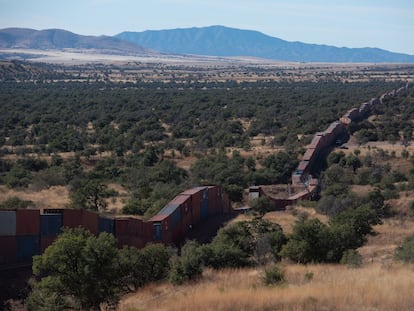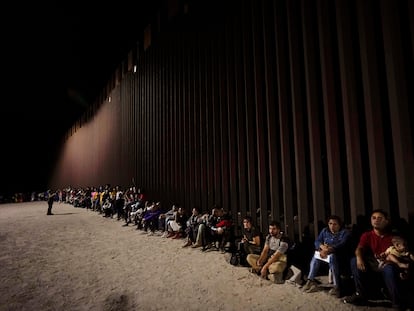Texas militarizes the Rio Grande between El Paso and Ciudad Juárez
Hundreds of migrants are camping on the riverbanks and in the streets of both cities as they wait for a Trump-era pandemic-containment measure to expire
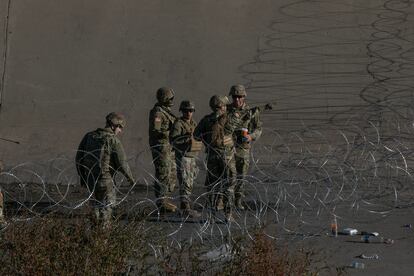

The state of Texas has militarized a 1,500-foot (500 meters) stretch of the border between El Paso and Ciudad Juárez in anticipation of the expiration of Title 42, a rarely-used clause of a 1944 public health law until the Trump administration began using it in 2020 to prevent migrants from entering the United States. Title 42 allows the US government to expel or prevent entry of people who have recently been in a country where a communicable disease was present.
On December 20, Texas Governor Greg Abbott (R) ordered National Guard troops to guard the river just days before the Trump-era policy was set to end. While it’s not the first time that the National Guard has been deployed to the border, images of barbed wire fences and troops along the Rio Grande ignited controversy in both countries. Juárez Mayor Cruz Pérez called it “excessive” and said that the presence of migrants “does not represent a threat to our neighboring country.”
When El Paso Mayor Oscar Leeser declared a state of emergency, Governor Abbott responded with troops and barbed wire. Leeser made the decision when hundreds of migrants began streaming across the river on December 19. Many were Nicaraguans who are difficult to deport because of extremely strained diplomatic relations between the US and Daniel Ortega’s administration. Mexico will not take them back either, so many were left to wander the streets of El Paso because all the migrant shelters were full.
The massive influx of migrants on December 19 and the ongoing exodus of people from atypical countries like Venezuela and Nicaragua, has strained the resources of US border states. In the month of October alone, US border authorities in El Paso received more than 50,000 migrants. Meanwhile, Governor Abbott has repeatedly criticized the Biden administration’s inaction and resorted to sending migrants by bus to Democrat-controlled cities and states.
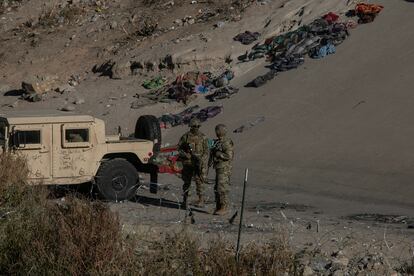
While a court battle rages between the federal government and several conservative states over the extension of Title 42, the Biden administration has said little about its plans for dealing with the migrant crisis. No action is expected until after Christmas, which could attract even more migrants to the border area. A cold snap that is enveloping the entire country is expected to drop temperatures below zero in El Paso by the Christmas weekend. Mayor Leeser has announced that several buildings are being accommodated as shelters, and the Red Cross has said it will provide 10,000 beds.
Meanwhile, hundreds of citizens from Central and South America have been trying for days to cross the Rio Grande and turn themselves in to US authorities to seek asylum. The migrants line up on the US side of the river along the border fence, and wait for the US Border Patrol and immigration officials to take them in groups to process their asylum applications. If and when Title 42 ends, the asylum application initiates a legal process with no guaranteed outcomes. Even so, asylum applicants see it as the best way to enter the US and await the outcome there.
Bureaucracy and reality
The migrants in the streets of Juárez and El Paso wait precariously in a state of confusion. Those who are still in Juárez, mostly Venezuelans, expect a definitive end to Title 42, since the directive was theoretically intended to prevent the spread of Covid-19 during the pandemic. But in practice, Title 42 prevents migrants from even starting the asylum process. Mexicans and Central Americans first ran into this bureaucratic wall and were forced to return to Mexico and apply for US asylum there. Then the Venezuelans started coming and collided with the same obstacle.
The US stopped accepting applications for asylum from Venezuelans a few months ago. Those that make it to Juárez worry that if they turn themselves in to US authorities, they will get sent back across the border where Mexican immigration authorities will move them inland to Mexico City or even further south. In October, Mexico began accepting Venezuelan migrants expelled from the US under Title 42.
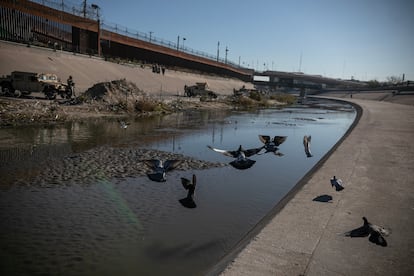
The situation in El Paso is just as bad or maybe worse than in Juárez. Hundreds of people wait in a shelter next to the Sacred Heart Church, just a few blocks from the official border crossing, for help getting out of the city and to their final destinations – Miami, Chicago, and even Canada. Most of them are Venezuelans who crossed the river before the National Guard arrived.
The migrants waiting in El Paso are facing a storm, metaphorically and literally. Most are not able to leave because they can’t afford a bus ticket. A cold front is quickly approaching, and no one is sure whether local authorities can handle all the people who need food and shelter. Many also wonder whether accepting help from El Paso authorities could jeopardize their chances of staying in the United States.
Given the influx of migrants from countries other than Mexico and the northern triangle of Central America, Title 42 may no longer be effective for containing irregular immigration. Hector Padilla, a researcher at the University of Ciudad Juárez and a former delegate from the National Institute of Migration in Chihuahua (Mexico), said that applying Title 42 may be counterproductive now because it doesn’t allow US authorities to punish repeat irregular border crossings. “When migrants and coyotes realized that there were no consequences to getting caught, they were prompted to try again and again. We then saw large increases in the number of people arriving at the border, as well as crossing attempts.”
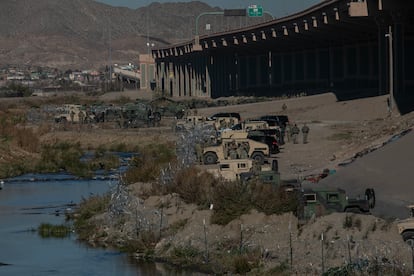
Sign up for our weekly newsletter to get more English-language news coverage from EL PAÍS USA Edition
Tu suscripción se está usando en otro dispositivo
¿Quieres añadir otro usuario a tu suscripción?
Si continúas leyendo en este dispositivo, no se podrá leer en el otro.
FlechaTu suscripción se está usando en otro dispositivo y solo puedes acceder a EL PAÍS desde un dispositivo a la vez.
Si quieres compartir tu cuenta, cambia tu suscripción a la modalidad Premium, así podrás añadir otro usuario. Cada uno accederá con su propia cuenta de email, lo que os permitirá personalizar vuestra experiencia en EL PAÍS.
¿Tienes una suscripción de empresa? Accede aquí para contratar más cuentas.
En el caso de no saber quién está usando tu cuenta, te recomendamos cambiar tu contraseña aquí.
Si decides continuar compartiendo tu cuenta, este mensaje se mostrará en tu dispositivo y en el de la otra persona que está usando tu cuenta de forma indefinida, afectando a tu experiencia de lectura. Puedes consultar aquí los términos y condiciones de la suscripción digital.
More information
Archived In
Últimas noticias
Most viewed
- Reinhard Genzel, Nobel laureate in physics: ‘One-minute videos will never give you the truth’
- Oona Chaplin: ‘I told James Cameron that I was living in a treehouse and starting a permaculture project with a friend’
- Pablo Escobar’s hippos: A serious environmental problem, 40 years on
- Why we lost the habit of sleeping in two segments and how that changed our sense of time
- Charles Dubouloz, mountaineering star, retires at 36 with a farewell tour inspired by Walter Bonatti
